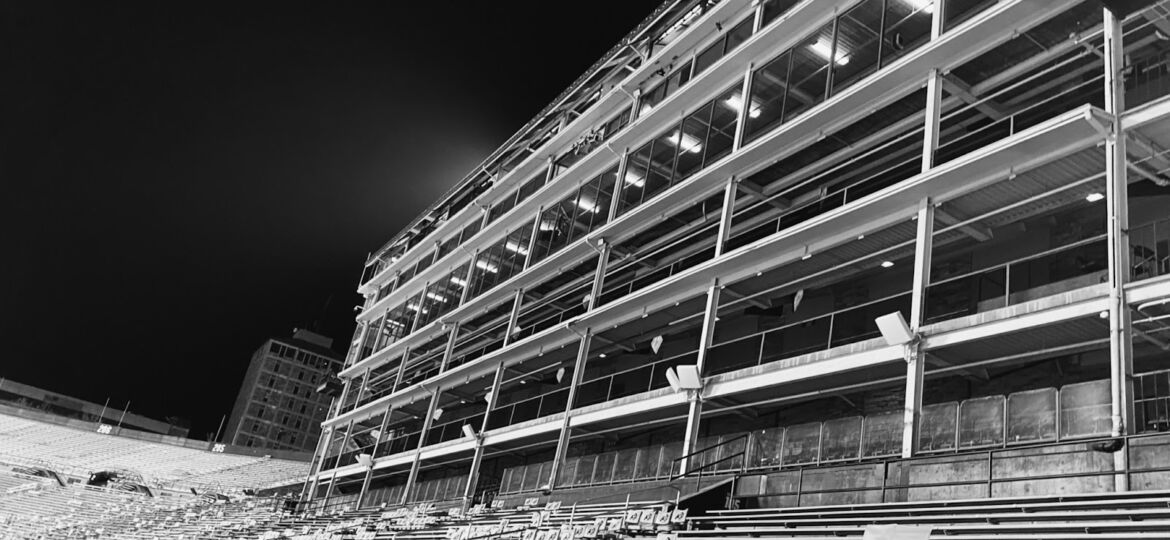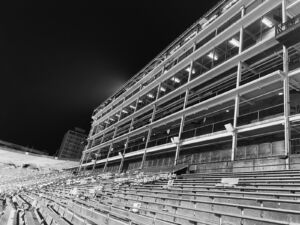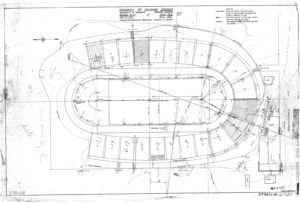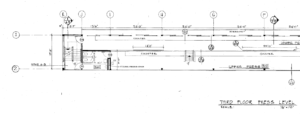
CU’s football team hasn't been the only thing stinking up Folsom Field:
How the social norms of the 19th century were built into the sports production industry

Folsom Field is arguably one of the most beautiful college football stadiums in the country, however, the social norms of the 1920s’ and 30s’ remain intact to this day. As the University of Colorado Boulder continues to celebrate the 50th anniversary of Title IX and the accomplishments of female athletes on the field, they fail to recognize their shortcomings off the field as more women enter the sports production industry.
While the stadium itself represents a great deal of inspiration to supporters of the university, to others it represents the failure to support an evolving workforce in the 21st century. The structure itself has set up an unspoken male dominated work culture within the Balch Fieldhouse (the press booths) which are used to cover football games at Folsom Field.
How so, you might ask? As the CU athletic program begins renovations with their football team, they might consider doing the same inside Balch Fieldhouse.
Due to the lack of women in the workforce, especially in the early stages of sports production in the 1930s’, the building resembles the social norms of the times. The construction was centered around American society when men were the breadwinners and women were simply the home makers.
Many individuals who weren’t white men were excluded from the press boxes which reporters occupied during sporting events. 85 years later, women have slowly chipped away at these expectations as they earn higher levels of education, higher positions in various industries, and continue to fight for equal pay.
As the university continues to celebrate the passing of Title IX 50 years later and the milestone it marks for millions in receiving equal opportunities, a simple restroom, or lack thereof, represents what little progress has actually been made when it comes to making room for women in sports production at CU. While this issue doesn’t necessarily concern a large number of employees here at the University of Colorado Boulder, it symbolically represents the constipation of progress when providing equal resources. We are reminded that the fight for equality in the workplace must continue, even here in Boulder.
The status quo of this particular environment remains unchanged, because many are afraid to ask questions and challenge an industry that has already labeled them as outsiders. Because why fix something that is already considered functional?
The ones who predominantly make up this field don’t notice these issues in the workplace because these conditions are suited to them, it’s not until someone, or rather an outsider like me, starts asking questions. A simple question like “where is the women’s restroom?”
The construction of Folsom Field took place in 1924 led by Mortenson Architectural Firm. The initial construction of the stadium cost the school about $65,000 which today with inflation is $1,132,794. There have been several additions to the stadium since the 1920s’ including Balch Fieldhouse in 1937, which includes a practice facility, and eight stories of press booths to cover football games.
There have also been several renovations such as an added 1,495 square feet of men’s bathrooms on the first floor and 477 square feet on the second floor of Balch Fieldhouse. It wasn’t until 1952 that the school added 499 square feet for women’s restrooms. This goes to show how much more space is designated to men than women inside Balch Fieldhouse.

Folsom Field has been around for quite some time, witnessing historical milestones such as the Great Depression, World War II, the Moon Landing, the creation of the internet, and the passing of Title IX, to name a few. The University continues to acknowledge and celebrate their inclusive culture here on campus and the progress brought by Title IX since 1972. CU takes pride in their progressive efforts when it comes to supporting both their men’s and women’s athletic programs, but under the surface there is still a lot of work to be done.
The Balch Fieldhouse is a monument signifying the times and social norms that it was constructed in. More outsiders have been given the opportunity to pursue careers in the sports production industry in the last 60 years. This is where a simple bathroom illustrates the schools willingness to make room for outsiders when providing insufficient resources in this particular environment.
There is a very small percentage still of outsiders in sports production, specifically at the University of Colorado Boulder, which explains why there has been little to no effort to change the culture within Balch Fieldhouse in regards to providing another bathroom in the upstairs floors. However, there has been a large increase in interest in pursuing careers in this industry in the last ten years.
There has been a lot of progress when it comes to making room for women in the workplace. Many universities and professional sports organizations have gone through extensive efforts in creating an inclusive and diverse environment in sports production. Yet, there is still a lot of work to be done as the grandchildren of the pioneers who promoted the passing of Title IX take their place in the workplace when pursuing a career in sports.

This industry is no exception to its masculine dominated culture, which sets the precedent for a normal workplace environment. There is only one “restroom” located on the fourth floor of Balch Field House. Having only two stalls and an exposed urinal, the only employees you see coming in and out of this space are men. The closest women’s restroom is located on the bottom two floors of the fieldhouse which is also used by fans attending the game.
This can be seen as problematic for some because instead of going down one or two stories, they are instructed to go down four or five stories depending on the floor they work on. But once the game starts, employees have very limited time to walk down five or six flights of stairs, while male employees are provided these amenities. Most female employees were very hesitant about their experiences while working during game days at Folsom Field. one shared how “as a female I feel like I need to be safe first and comfortable to be able to use a restroom that’s for women” during the interview. She asked to remain anonymous.
When asking another employee, who wants to remain anonymous, she shared that they had to leave the stadium and use the restrooms at the Duane Physics Building, about a 10 minute walk outside the stadium.
In an interview, they shared that “we’re advised to go outside, but it would be easier to use a facility here.”
These employees’ experiences are a result of the culture within Balch Fieldhouse. Because of the small percentage of female employees who work in this facility on game days, there has been no effort in improving these working conditions. Hopefully the school will consider making some changes leading up to the 2023 football season next fall.
The practice of advocacy is vital when it comes to creating an equal playing field in the workforce. Recently, we tend to overlook the little things that cause the bigger problems that create obstacles in making progress. What began with a bathroom ended up revealing a culture of exclusion that has been upheld for decades, and as the glass ceiling begins to crack under the pressure of advocacy, we have to make noise for it to shatter.
As an outsider and advocate, catching the attention of spectators who unintentionally uphold the ideologies of the 1920s’ is the first step. The exclusive culture that has been ingrained into the foundation of Folsom Field comes to show that there is still work to be done as we celebrate the marker of progress brought by TItle IX. As the CU football team undergoes their own reconstruction following the hiring of Deion Sanders, maybe it’s time to do the same at Balch Fieldhouse.
And while it’s intimidating having these uncomfortable conversations that are easier left unsaid, in the wise words of Ted Lasso, we must “be curious.”

